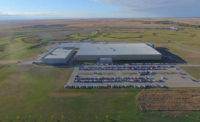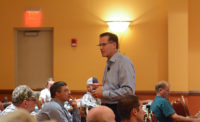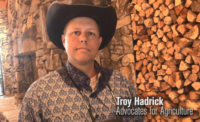Conference review
CAB Conference: Connecting with real producer passion

A panel of cattle producers shares their insights with attendees during the Certified Angus Beef (CAB) brand’s annual conference in San Antonio.
Photos courtesy of Certified Angus Beef LLC

Kansas cattle rancher Debbie Lyons-Blythe addresses attendees at the Certified Angus Beef (CAB) brand’s annual conference this fall.
Photos courtesy of Certified Angus Beef LLC


The word “passion” is overused. Passion is more than a romantic lifestyle or down-home values.
When communicating with those who merchandise, serve and represent beef to consumers, it’s hard to describe the commitment and sense of purpose most farmers and ranchers share.
Instead of relying on second-hand accounts, many from just about every link in the beef chain heard stories directly from agriculture’s people at the Certified Angus Beef (CAB) brand’s annual conference in late September. More than 500 attendees from retail and foodservice, to processors and exporters gathered at the event in San Antonio.
The stories painted pictures.
“One day I went down to the river to see where our discharge met the river and — I’m not kidding you — about 20 yards down the river were three little boys swimming,” said Cargill’s Nicole Johnson-Hoffman. She said the beef packer returns river water from its plants in better condition than when it enters those plants. “I know my job is critically important.”
Other panelists included consulting veterinarian Tom Noffsinger of Production Animal Consultants, cattle feeder John Butler of Beef Marketing Group (BMG), and Angus breeders Kevin and Lydia Yon, of Yon Family Farms, in Ridge Spring, S.C.
They weighed in on questions ranging from water use and the “local” movement to animal handling and countering misguided activists.
“It’s absolutely amazing to me what happens to a feedlot, a community, a country, a world, when animals and people are doing things because they want to and not because they have to,” Noffsinger said, noting animal behavior is better understood today. “It turns the image of daily activity around in a very positive fashion.”
He teaches animal handling that centers on building trust between cattle and caregivers.
“Our tools to communicate with these creatures are limited to our posture, our position, our attitude, relationship of the angle that we take, and then the speed of movement,” Noffsinger explained.
Once cattle trust, everything improves.
“The most important medicine we have is the animal’s own immune response,” he said. One example is young animals nursing dozens of times a day are much healthier than those that nurse only once or twice.
Noffsinger’s team consults on 1.2 million feedlot cattle each month and works to reduce sickness at critical control points.
“We’ve noticed that our biggest health problems happen near a change of address,” he said.
A theme of the panel was collaboration and illustrating how separate businesses all work together for the good of the consumer.
BMG is a network of finishing operations that finish more than 600,000 head of cattle each year, Butler said. Why that many?
“When we look at how we can play a role in producing a consistent product on a consistent basis, we can’t do it with 100 cows. We can’t do it with 10,000 cattle in a feedyard, because we have to deliver a relevant number of pounds of product to someone every week,” he said, noting the company’s close relationship with Tyson. “That’s very key so that we can produce it on a consistent basis. If we don’t have communication, we don’t have transparency and we can’t do that.”
BMG feedyard operators share common goals, Butler said: “We try not to mess up good genetics and we try to take those animals to their optimum finishing point and produce a high-quality product.”
But they are also trying to make environmental improvements and respond to consumer demands. They’re working to make “sustainability” improvements.
The definition of that buzzword varies somewhat, but Johnson-Hoffman, who chairs the U.S. Roundtable for Sustainable Beef, distilled it to three questions.
“For us that just means, ‘Is it environmentally sound? Is it socially responsible? Is it economically viable?’ If the answer is ‘yes,’ then it’s probably sustainable,” she said. “Cows are a miraculous animal. They take inedible [to humans] forage and turn it into the finest protein known to man.”
To the Yon family, sustainability also means allowing their children to come back to the farm, if they choose to do so.
Lydia Yon said when they’d come home for Christmas break during college, the kids’ first question was predictable: “When are we going to synchronize cows?”
They joked about being the manual labor force, but all of that had a purpose, she said.
“Our goal all along was to teach them work ethic and a responsibility, and for them to learn respect for the environment and the animals — and then they could take that to whatever profession they chose,” Lydia Yon said. “We don’t want them to think they just come back and automatically get the ‘keys to the kingdom,’ though. They’ve got to come back with unique talents.”
The couple has encouraged internships as a way to build skills to bring to the seedstock business.
Prior to the panel discussions, Debbie Lyons-Blythe provided a snapshot of life on her Kansas cattle ranch, and also talked of passing down the legacy to her five children.
“They are all vitally important to our labor force and even though they are in college or graduated, we do plan work for when they can come home and give us a hand,” she said. “They are also part owners in our ranch, so in time, we hope to give them more of the management duties and we will transition to their ownership and responsibility.”
During Lyons-Blythe’s remarks, she shared a scrolling loop of pictures of her kids, ranch and herd, and talked of teamwork during blizzards and kids growing up checking cattle with her.
When the session closed, nearly 40 more crowd-submitted questions remained. The company promised to answer those post-conference and did so in short order.
CAB set up the exchange to help those who market beef to consumers get a glimpse of what cattlemen and women put into the process of creating that beef.
“It’s a real privilege to us to know we are the starting point,” Lydia Yon said. “But it’s real humbling to know we better not mess up.” NP
Looking for a reprint of this article?
From high-res PDFs to custom plaques, order your copy today!





